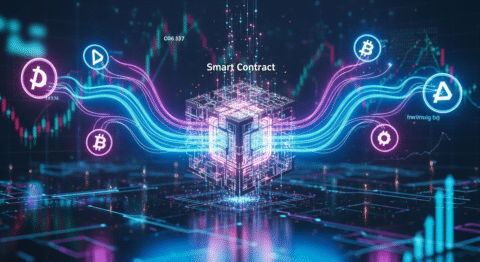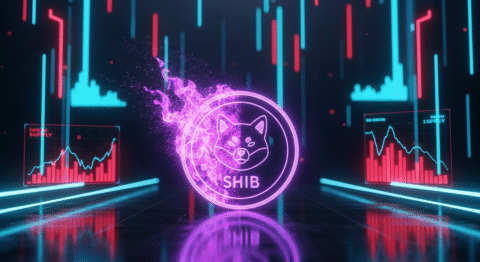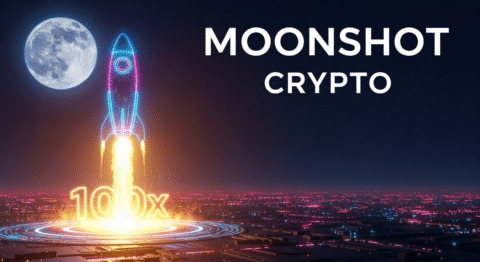Contract Address: 5 Ways to Spot Real Altcoins & Meme Coins
Has the allure of a 100x altcoin or the unpredictable thrill of a meme coin captured your imagination? With the crypto market constantly churning out new tokens, navigating its vast landscape can feel like searching for a needle in a digital haystack. But what if a simple string of characters could be your guiding light? The Contract Address might just be the key to unlocking genuine projects and dodging prevalent scams. Understanding this fundamental element can empower you to make more informed investment decisions in the dynamic world of digital assets.
Crypto Market Overview: A Digital Gold Rush in Progress
The cryptocurrency market is a perpetual motion machine, and the current landscape is no exception. Altcoins, often seen as alternatives to Bitcoin, continue to carve out their niches, ranging from sophisticated DeFi protocols to innovative utility tokens. Meme coins, born from internet culture and social media fervor, have also demonstrated explosive growth potential, albeit with equally explosive volatility. According to CoinMarketCap data, the altcoin market capitalization recently surpassed a significant milestone, indicating sustained investor interest beyond Bitcoin and Ethereum. Airdrops, meanwhile, remain a popular method for token distribution, offering new users a chance to acquire digital assets, though the quality and legitimacy of airdropped tokens vary wildly.
Navigating this dynamic environment requires a keen eye for detail and a deep understanding of what constitutes a genuine opportunity. The sheer volume of new tokens launched daily means that skepticism is not just healthy, but essential. This is where the humble Contract Address becomes your most powerful ally. It’s the unique identifier of a cryptocurrency on its native blockchain, the digital fingerprint that tells you exactly which token you’re interacting with. Incorrectly identifying a token can lead to accidental transactions, lost funds, or even direct involvement in malicious schemes. Mastering the use of the Contract Address is therefore not just a technical skill; it’s a crucial security measure for anyone participating in the altcoin and meme coin space.

The Core Concept: How the Contract Address Actually Works
What is a Contract Address in the Crypto Universe?
At its heart, a Contract Address is a unique identifier for a smart contract deployed on a blockchain. Think of it as the digital street address for a decentralized application or a cryptocurrency token. Every token, whether it’s a utility token, a governance token, or even a meme coin, lives on a specific blockchain and has a unique Contract Address associated with it. This address is generated when a smart contract is deployed to the blockchain and remains permanent. It’s a public record, meaning anyone can look up the Contract Address on a blockchain explorer to verify information about the token. This transparency is a cornerstone of the blockchain’s security and immutability.
When you interact with a cryptocurrency – be it buying, selling, or transferring – you are essentially interacting with the smart contract at its Contract Address. This address dictates how the token behaves, including its supply, how it can be transferred, and any special functionalities it possesses, such as burning mechanisms or staking rewards. Without a valid Contract Address, a token simply doesn’t exist in the digital realm of a blockchain. For a burgeoning altcoin contract, this address is its very identity.
Key Components & Technologies: The Backbone of Digital Assets
The functionality and existence of cryptocurrencies, especially altcoins, are underpinned by robust blockchain technology. Most commonly, tokens are built on smart contract platforms like Ethereum, Binance Smart Chain (BSC), Solana, or Polygon. These blockchains enable the creation and execution of self-executing contracts with the terms of the agreement directly written into code.
For example, on the Ethereum blockchain, most tokens adhere to standards like ERC-20 (for fungible tokens) or ERC-721 (for non-fungible tokens, or NFTs). These standards define a common interface, ensuring that wallets and exchanges can interact with different tokens seamlessly. When you see an altcoin contract, it’s typically deployed using one of these established standards.
The Contract Address itself is a hexadecimal string, usually starting with “0x” followed by 40 characters. This address points directly to the location on the blockchain where the token’s smart contract code resides. Understanding this mechanism is vital because it allows you to independently verify the authenticity and details of any cryptocurrency before investing. For instance, if a project claims to be a new ERC-20 token but its purported Contract Address doesn’t function as expected or lacks the standard elements, it’s a major red flag.
The Data-Driven Perspective: Unpacking Performance and Trust
Market Data & Trends: Gauging Altcoin and Meme Coin Momentum
The cryptocurrency market data offers a wealth of insights into the performance and popularity of altcoins and meme coins. Platforms like CoinMarketCap, CoinGecko, and DeFi Llama provide real-time data on market capitalization, trading volume, price charts, and community sentiment. For instance, tracking the 24-hour trading volume associated with a specific Contract Address can reveal how actively a token is being traded. A sudden spike in volume without a corresponding positive news event might indicate manipulation or pump-and-dump activity.
Moreover, analyzing historical price data can help identify patterns and potential trends. While past performance is not indicative of future results, understanding how a token has behaved in different market conditions can offer valuable context. For meme coins, price movements are often driven by social media trends and celebrity endorsements rather than underlying utility, making them particularly volatile. Data trends can highlight periods of intense hype followed by sharp declines, a common narrative for many meme coins. For investors assessing an altcoin contract, looking at its listing on reputable decentralized exchanges (DEXs) and its trading volume across multiple platforms is a crucial first step.
Tokenomics & Market Health: The Foundation of Value
Tokenomics refers to the economic design of a cryptocurrency, including its total supply, distribution, and utility. Analyzing the tokenomics is paramount when evaluating the long-term potential and health of an altcoin or meme coin. A well-designed tokenomics model should incentivize holding, provide clear utility, and manage supply effectively to prevent hyperinflation.
For example, a common tokenomic strategy involves “burning” tokens, where a portion of tokens are permanently removed from circulation, thus reducing supply and potentially increasing value. You can often verify these mechanisms by examining the smart contract code accessible through blockchain explorers. If a project claims a deflationary model, you should be able to see evidence of token burns associated with its Contract Address.
Conversely, an overly concentrated distribution of tokens, where a few wallets hold a significant percentage of the supply, can be a warning sign. If a few “whales” decide to sell their holdings, it can cause the price to plummet, impacting all other holders. Examining the first transactions from a newly launched altcoin contract can reveal whether a large portion of tokens was pre-mined and allocated to the developers or early investors. This “insider” control can lead to market manipulation.
Risks, Challenges & Competition: Navigating the Scavenger Hunt
Risks of Altcoins and Meme Coins: The Double-Edged Sword of Innovation
While the potential rewards of altcoins and meme coins can be substantial, the risks are equally significant. Volatility is a given; prices can swing wildly in short periods. Security vulnerabilities within smart contracts are another major concern. Exploits can lead to millions of dollars in stolen funds, as has been seen in various DeFi hacks. Ensuring the smart contract code governing a token has been audited by reputable security firms is a critical step in risk mitigation.
Regulatory uncertainty also looms large over many altcoins and meme coins. Governments worldwide are still developing frameworks for digital assets, and new regulations could impact the legality and accessibility of certain tokens. Furthermore, the space is rife with scams, including rug pulls, where developers abandon a project after attracting investment, taking funds with them. Misinformation and hype cycles, particularly around meme coins, can lead investors to make decisions based on emotion rather than due diligence, a common pitfall. The Contract Address can offer a degree of transparency, but it doesn’t inherently shield you from market risks or malicious intent.
How Does a Genuine Altcoin Contract Stack Up Against Competitors?
When evaluating an altcoin, it’s crucial to understand its competitive landscape. Does it offer a unique solution to an existing problem, or is it a clone of a more established project? A comparative analysis helps in identifying true innovation versus mere imitation.
| Feature | Project A (Example Altcoin) | Project B (Competitor) | Project C (Meme Coin) |
|---|---|---|---|
| Blockchain | Ethereum | Binance Smart Chain | Solana |
| Token Utility | DeFi lending/borrowing | NFT marketplace | Community engagement |
| Tokenomics | Deflationary (token burns) | Inflationary (staking rewards) | Fixed supply |
| Smart Contract Audit | Yes, by CertiK | No | N/A (often simple) |
| Community Size | Growing (10k Discord) | Large (100k Telegram) | Massive (500k Twitter) |
| Liquidity | High on Uniswap | Moderate on PancakeSwap | Low on Raydium |
| Innovation | Novel consensus mechanism | Unique staking rewards | Cultural relevance |
A genuine altcoin contract typically demonstrates clear utility, sound tokenomics, and evidence of development and security. Competing projects may offer similar functionalities but differ in their underlying technology, community approach, or economic incentives. Meme coins, while potentially profitable, often lack inherent utility, with their value primarily driven by community enthusiasm and speculation. When comparing, always cross-reference information from multiple sources and scrutinize the details associated with a project’s Contract Address.
The Future Outlook: What’s Next for Altcoins and Meme Coins?
What’s Next for Altcoins and Meme Coins?
The future of altcoins and meme coins will likely be shaped by ongoing technological advancements, evolving regulatory landscapes, and shifting investor sentiment. For altcoins, we can expect to see continued innovation in areas like scalability solutions, interoperability between blockchains, and decentralized autonomous organizations (DAOs). Projects that offer tangible utility, strong development teams, and robust community governance are more likely to thrive. The adoption of Layer 2 scaling solutions is also paving the way for more efficient and cost-effective transactions, which could boost the usability of many altcoins.
Meme coins, on the other hand, will probably continue to be driven by internet culture and social media trends. While some may fade into obscurity, others could evolve to incorporate utility or build strong, engaged communities that sustain their value. The lines between utility tokens and meme coins are also becoming increasingly blurred, with many projects attempting to fuse both aspects. As blockchain technology matures, we might see more sophisticated meme coins that, while fun, also offer some underlying value or governance. For anyone delving into these markets, staying informed about the latest developments related to any given altcoin contract will be crucial.
Conclusion: Empowering Your Crypto Journey
Navigating the decentralized world of cryptocurrencies requires diligence and a keen understanding of the tools at your disposal. The Contract Address is more than just a string of characters; it’s your primary verification tool. By learning to identify genuine tokens through their Contract Address, understanding tokenomics, analyzing market data, and being aware of the inherent risks, you can significantly improve your chances of making sound investment decisions and avoiding common pitfalls.
What are your strategies for vetting new altcoins or meme coins? Do you have any favorite tools for verifying altcoin contract information? Share your thoughts and experiences in the comments below to help fellow investors! For more insights into the ever-evolving crypto space, be sure to subscribe to our newsletter and explore our related articles on [mention a related blog post topic, e.g., “Understanding DeFi Yield Farming”].
FAQs
Q1: How can I find the Contract Address for a specific cryptocurrency?
You can usually find the official Contract Address on the project’s official website, their whitepaper, or reputable cryptocurrency data aggregators like CoinMarketCap or CoinGecko. Always cross-reference the address from multiple trusted sources to avoid using a fake one.
Q2: What is the difference between a Bitcoin address and a Contract Address?
A Bitcoin address is used for sending and receiving Bitcoin, which operates on its own blockchain without smart contracts in the same way as Ethereum. A Contract Address, typically found on platforms like Ethereum, refers to a specific smart contract program that governs a token, defining its rules and functionalities.
Q3: Can I use a Contract Address to see the transaction history of a token?
Yes, you can use a Contract Address on blockchain explorers (like Etherscan for Ethereum, BscScan for Binance Smart Chain, etc.) to view all transactions related to that specific token, including its issuance, transfers, and any smart contract interactions.
Q4: What does an “unverified contract” warning mean?
An “unverified contract” on blockchain explorers means that the source code of the smart contract has not been publicly disclosed and verified by the project team. This can be a significant red flag, as it makes it impossible to audit the contract for malicious code or to confirm its intended functionality. Always prefer verified contracts associated with a known altcoin contract.
Q5: How do I avoid rug pulls when investing in new meme coins?
To avoid rug pulls, thoroughly research the project behind the meme coin. Look for: a publicly visible and verified Contract Address, a locked liquidity pool (where tokens are locked and cannot be easily removed by developers), a clear roadmap, active community engagement, and audits by reputable security firms. Be wary of projects with anonymous teams or promises of unrealistic returns.






